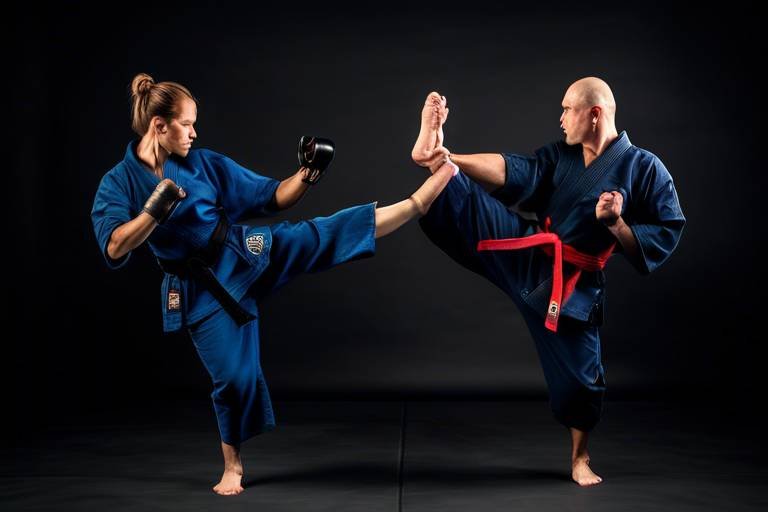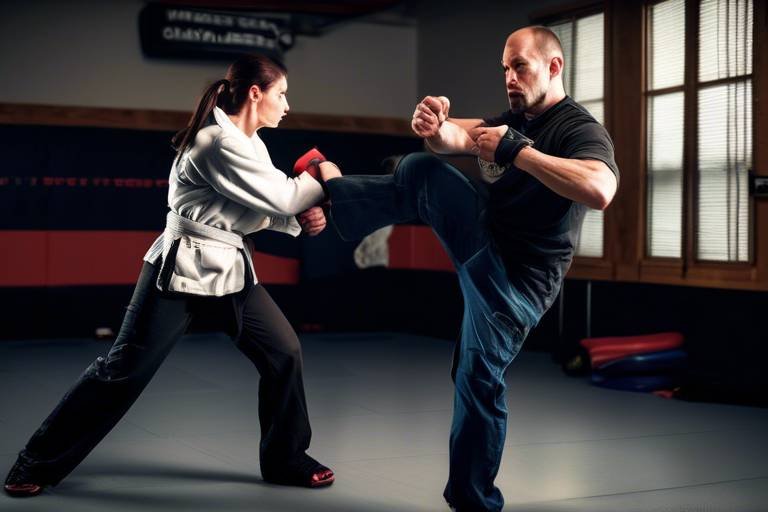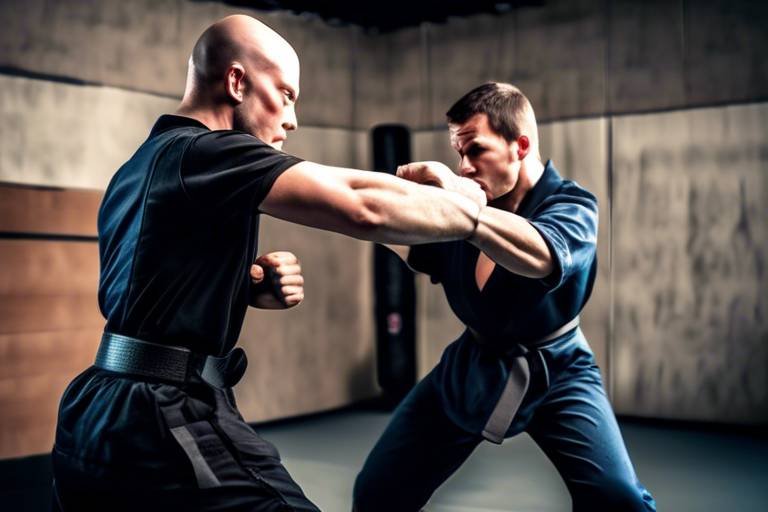The Importance of Regular Practice in Mastering Self-Defense Techniques
When it comes to mastering self-defense techniques, one of the most critical factors is regular practice. Just like learning to play a musical instrument or perfecting a sport, self-defense requires a commitment to consistent training. Imagine trying to play your favorite song on the piano without ever practicing the notes—it's simply not going to happen! Similarly, without regular practice, your self-defense skills will remain just that—skills that are never fully developed. This article dives into why consistent practice is not only essential but also transformative for anyone looking to enhance their self-defense abilities.
One of the primary benefits of regular practice is the enhancement of muscle memory. This concept refers to the brain's ability to store and recall specific movements through repetition. When you practice self-defense techniques regularly, you're effectively creating and strengthening neural pathways that enable your body to react instinctively during confrontations. Think of it as building a road in your brain that becomes smoother and faster with each trip. When faced with a high-pressure situation, the ability to respond quickly and accurately could make all the difference between safety and danger.
Moreover, consistent practice is a fantastic way to build confidence. As you become more proficient in your techniques, you'll notice a significant shift in how you perceive your abilities. It's much like learning to ride a bike; at first, you might feel wobbly and unsure, but with practice, you gain balance and control. This newfound confidence not only empowers you to handle potential threats more effectively but also serves as a deterrent to aggressors. When someone sees that you carry yourself with assurance, they may think twice before approaching you with ill intentions.
To maximize the benefits of practice, it's essential to implement effective techniques. Structured practice routines can significantly enhance skill acquisition. For instance, engaging in shadowboxing allows you to visualize an opponent and practice your moves without the pressure of a partner. Partner drills provide the opportunity to work with someone else, offering valuable feedback and a chance to simulate real-life scenarios. Additionally, incorporating scenario training can prepare you for various situations you may encounter, making your training more comprehensive and applicable.
When considering how to practice, it's important to weigh the advantages of both solo and partner practice. Solo practice allows for personal reflection and fine-tuning of your techniques, while partner practice provides a dynamic environment where you can receive immediate feedback and adapt your skills in real-time. Each method has its unique benefits, and combining both can lead to a well-rounded training experience.
Another vital aspect of self-defense training is sparring. This component is essential because it allows you to apply your techniques against a live opponent, enhancing your timing, distance management, and adaptability under pressure. Sparring is like a dance—each partner must be in sync, and the more you practice, the more fluid your movements become. This practice not only prepares you for actual confrontations but also builds resilience and quick thinking, which are crucial in high-stress situations.
Setting realistic goals is also key to maintaining motivation in your self-defense training. By establishing achievable short-term and long-term objectives, you can track your progress and celebrate milestones along the way. This sense of accomplishment reinforces your commitment to regular practice, making it easier to stay focused on your self-defense journey.
Consistency is the golden rule when it comes to mastering self-defense techniques. Regular practice not only reinforces your skills but also helps build a habit, ensuring that these techniques become second nature. In emergencies, the last thing you want is to hesitate or second-guess yourself. With consistent training, your body will instinctively know how to react, allowing you to respond effectively when it matters most.
Creating a practice schedule can be a game-changer in maintaining consistency. By setting aside dedicated time for training, you prioritize self-defense in your life, leading to continuous improvement and skill retention over time. Just like any other important commitment, treating your practice sessions with the same seriousness can yield remarkable results.
Of course, many practitioners encounter obstacles that can hinder regular practice. Identifying and addressing these challenges—whether they be time management or motivation issues—is crucial for maintaining a consistent self-defense training routine. Remember, every journey has its bumps in the road, but overcoming these obstacles is part of the growth process.
- How often should I practice self-defense techniques? Aim for at least 2-3 times a week to see significant improvements.
- Can I practice self-defense alone? Yes, solo practice is beneficial, but incorporating partner drills enhances learning.
- What is the best way to build muscle memory? Repetition and consistent practice are key to developing muscle memory.
- How can I stay motivated to practice regularly? Set realistic goals, track your progress, and celebrate your achievements.
- Is sparring necessary for self-defense training? Yes, sparring helps you apply techniques in real-time, improving your adaptability.

The Role of Muscle Memory
Muscle memory is one of those fascinating phenomena that can make a world of difference in mastering self-defense techniques. Imagine your body as a well-tuned instrument; the more you play it, the better it sounds. Similarly, the more you practice self-defense moves, the more instinctive they become. This is the essence of muscle memory—your body learns to execute techniques automatically, allowing you to react without overthinking when faced with a potential threat.
When you engage in regular practice, you are not just repeating movements; you are strengthening neural pathways in your brain. This process is akin to carving a path through a dense forest. The more you walk that path, the clearer and easier it becomes to navigate. In self-defense, this means that during high-pressure situations, your body can recall the necessary actions quickly and accurately. It's not just about knowing the moves; it's about being able to perform them under stress.
Think about it: in a real confrontation, your adrenaline levels spike, and your heart races. In such moments, you don’t have the luxury of time to think through each step. Instead, your body must rely on the muscle memory developed through countless hours of practice. This is why consistency in training is so crucial. It’s not just about learning techniques; it’s about embedding them in your muscle memory so that they become a natural part of your reflexes.
To illustrate this, consider the following table that outlines the benefits of muscle memory in self-defense:
| Benefit | Description |
|---|---|
| Instinctive Reactions | Allows for quick responses without conscious thought. |
| Improved Accuracy | Enhances precision in executing techniques during confrontations. |
| Reduced Anxiety | Familiarity with techniques lowers stress levels when facing threats. |
| Enhanced Coordination | Develops better body control and movement fluidity. |
In conclusion, the role of muscle memory in self-defense cannot be overstated. It’s the foundation upon which your skills are built, allowing you to face real-life situations with confidence and poise. So, the next time you step onto the training mat, remember that every repetition is not just a step towards mastering a technique; it’s a step towards ensuring that your body knows exactly what to do when it matters most.
As you continue your training, consider incorporating drills that specifically target muscle memory. This could include shadowboxing, where you visualize an opponent while practicing your moves, or performing techniques in slow motion to focus on form. The more you engage with your training, the more your body will respond naturally, turning those practiced moves into instinctual actions.
- What is muscle memory? Muscle memory refers to the process where your body learns and remembers movements through repetition, allowing for instinctive responses during physical activities.
- How long does it take to develop muscle memory? The time it takes to develop muscle memory can vary based on the individual and the complexity of the movements. Generally, consistent practice over weeks or months is required for significant improvement.
- Can muscle memory be lost? Yes, if you stop practicing for an extended period, your muscle memory can diminish. However, with a return to training, those skills can often be reacquired more quickly than when first learned.

When it comes to mastering self-defense techniques, repetition is not just a method; it's a crucial building block for developing confidence. Imagine standing in front of a mirror, practicing your moves over and over again. Each time you perform a technique, you're not just repeating the action; you're reinforcing your brain's understanding of what to do in a real-life situation. This constant practice creates a sense of familiarity that transforms uncertainty into assurance. It’s like learning to ride a bike; the more you practice, the more second nature it becomes. You no longer think about balancing or pedaling; you just do it!
As you engage in regular practice, something magical happens: you begin to trust your instincts. This trust is essential when faced with a potential threat. For instance, if someone were to confront you unexpectedly, your body will respond instinctively, drawing upon the muscle memory you’ve developed. It’s not just about knowing how to execute a technique; it’s about feeling confident in your ability to do so. The more you practice, the more your mind and body align, creating a powerful synergy that enhances your overall self-defense capabilities.
Moreover, repetition allows you to refine your skills continuously. Each practice session is an opportunity to identify areas for improvement. You might notice that your stance is off or that your timing needs adjustment. This self-awareness is vital for building confidence. As you correct these small details, you become more adept at executing techniques flawlessly. This improvement not only boosts your confidence but also decreases anxiety in high-pressure situations. You start to realize that you can handle yourself, which is an empowering feeling.
It's also worth mentioning that practicing in a supportive environment can significantly enhance this confidence-building process. Training with friends or in a class setting provides a safety net. You can make mistakes, learn from them, and grow together. It’s like being part of a team where everyone is cheering for your success. This camaraderie can be incredibly motivating, pushing you to practice more often and with greater intensity.
In conclusion, building confidence through repetition is a journey that every self-defense practitioner should embrace. Regular practice not only solidifies your techniques but also cultivates a mindset of resilience and self-assurance. So, the next time you step onto the training mat, remember that every repetition is a step towards becoming a more confident and capable individual.
- How often should I practice self-defense techniques?
It’s recommended to practice at least 2-3 times a week to build and maintain your skills effectively. - Can I practice self-defense techniques at home?
Absolutely! Solo practice can be very effective, especially for refining techniques and building muscle memory. - What should I focus on during practice sessions?
Focus on both technique and application. Work on your form, but also simulate real-life scenarios to enhance your adaptability.

When it comes to mastering self-defense techniques, the way you practice can make all the difference. It's not just about going through the motions; it's about engaging in effective practice that truly enhances your skills. One of the best ways to achieve this is by implementing structured practice routines. Think of these routines as the backbone of your training. They provide a framework that keeps you focused and ensures that you cover all the necessary aspects of self-defense.
One highly effective method is shadowboxing. This technique allows you to visualize an opponent while practicing your strikes, footwork, and defensive maneuvers. Imagine you're in a real fight—this mental engagement helps solidify your techniques in your mind and body. Shadowboxing not only improves your form but also enhances your timing and rhythm. It’s like rehearsing for a play; the more you practice, the more natural it feels when the curtain rises.
Another valuable technique is engaging in partner drills. These drills provide an opportunity to practice your skills against a live opponent, which is crucial for developing timing and distance management. You can work on specific techniques, such as joint locks or escapes, while receiving immediate feedback from your partner. This interaction not only sharpens your skills but also builds a sense of camaraderie. Think of it like dancing; you need a partner to learn the moves and to truly understand the flow of the dance.
Then there's scenario training, which takes your practice to another level. In this method, you simulate real-life situations that you might encounter. For instance, you might practice defending against an attack from behind or dealing with multiple attackers. This type of training is invaluable because it forces you to think on your feet and adapt your techniques to dynamic situations. It’s akin to a fire drill; you might know the exit routes, but practicing them under pressure ensures you’re ready when it really counts.
As you incorporate these techniques into your training, remember that consistency is key. Regularly practicing these methods will not only enhance your skill set but also build your confidence. The more you practice, the more instinctive your responses will become, making it easier to react appropriately in high-pressure situations. So, take the time to develop a well-rounded practice routine that includes shadowboxing, partner drills, and scenario training. Your future self will thank you!
- How often should I practice self-defense techniques? Consistency is crucial, so aim for at least two to three times a week to see significant improvements.
- What if I don't have a partner to practice with? Solo practice is still beneficial! Shadowboxing and working on your footwork can be done alone.
- Are there any specific drills I should focus on? Yes, focus on basic techniques, situational drills, and sparring to develop a comprehensive skill set.
- Can I practice self-defense at home? Absolutely! Many techniques can be practiced in your living room or backyard, just ensure you have enough space.

When it comes to mastering self-defense techniques, the debate between solo and partner practice is one that many practitioners face. Both methods have their distinct advantages, and understanding these can significantly enhance your training experience. Solo practice allows you to focus on personal reflection and technique refinement. Imagine being able to practice your moves in front of a mirror, where you can see every detail of your form and adjust accordingly. This can lead to an intimate understanding of your body mechanics and how each technique feels when executed correctly.
On the flip side, partner practice opens the door to real-world application. There's a unique dynamism that comes from working with another person. You can simulate real-life scenarios, which is invaluable for preparing for actual confrontations. When you practice with a partner, you receive immediate feedback on your techniques, which can help you identify weaknesses and areas for improvement. This interaction mimics the unpredictability of a real encounter, pushing you to adapt and respond to an opponent's movements.
However, it’s essential to recognize that both methods can complement each other. For example, you might spend time honing your techniques solo, focusing on precision and speed, and then transition to partner practice to apply what you've learned in a more dynamic setting. This blend of practice styles creates a comprehensive training regimen that can prepare you for various situations.
To truly maximize your training, consider integrating both solo and partner practice into your routine. This balanced approach not only enhances your skills but also keeps your training engaging and effective. Remember, the goal is to build a solid foundation that allows you to react instinctively, whether you’re practicing alone or with a partner.
- What is the best way to practice self-defense techniques alone? Focus on shadowboxing, reviewing techniques in front of a mirror, and practicing footwork to enhance your agility and form.
- How can I find a good partner for practice? Look for a training partner in your self-defense class, or join local martial arts clubs where you can meet like-minded individuals.
- Is it necessary to practice with a partner? While solo practice is beneficial, practicing with a partner provides essential feedback and simulates real-life scenarios, making it a critical component of your training.

Sparring sessions are not just an exciting part of self-defense training; they are a critical component that can significantly enhance your skills. Think of sparring as a live-action rehearsal for a play. Just like actors need to practice their lines and movements to perform seamlessly on stage, self-defense practitioners must engage in sparring to bring their techniques to life. It’s where theory meets reality, and the magic happens!
During sparring, you have the opportunity to apply the techniques you’ve learned in a dynamic and unpredictable environment. This is where you start to understand the nuances of distance, timing, and the psychological aspects of a confrontation. You might think you know how to execute a particular move, but when faced with a moving opponent, everything changes. Suddenly, you’re not just practicing a technique; you’re adapting it to a real situation, which is both challenging and exhilarating.
Moreover, sparring sessions help develop critical thinking skills. You learn to read your opponent's movements and anticipate their next actions, much like a chess player predicts their opponent's moves. This mental engagement is crucial because self-defense isn’t just about physical prowess; it’s about making quick decisions under pressure. As you spar more, you’ll find yourself becoming more adaptable, which is essential for handling the unpredictable nature of real-life confrontations.
It’s also important to note that sparring isn’t just about going all out. It can be structured in various ways to suit different skill levels and training goals. For beginners, light sparring can help build confidence without the fear of injury. For more advanced practitioners, full-contact sparring can provide the adrenaline rush and realism necessary for honing their skills. The key is to find a balance that allows for safe but effective practice.
Incorporating sparring sessions into your training routine can also promote camaraderie among practitioners. The shared experience of sparring fosters a sense of community and support, making training more enjoyable. You learn from each other, share tips, and celebrate victories together, creating bonds that can last a lifetime.
In conclusion, sparring is an essential aspect of mastering self-defense techniques. It transforms theoretical knowledge into practical skills, enhances critical thinking, and builds a supportive community. So, if you haven’t already, it’s time to step onto the mat, face your training partner, and embrace the challenge of sparring!
- What is the best way to prepare for a sparring session?
Warming up properly and practicing your techniques in drills can help you get ready for sparring. It’s also beneficial to mentally prepare by setting goals for what you want to achieve during the session.
- How often should I spar?
This depends on your training schedule and goals. Many practitioners find that sparring once or twice a week is a good balance, allowing them to practice techniques while also focusing on other aspects of their training.
- Is sparring safe?
When conducted with proper safety gear and under the supervision of experienced instructors, sparring can be a safe and effective way to practice self-defense techniques. Always communicate with your partner and respect each other's limits.

Setting realistic goals in your self-defense training is not just about having something to aim for; it’s about creating a roadmap that guides your journey towards mastery. Think of it as planning a road trip: without a destination, you might end up wandering aimlessly. By establishing clear, achievable objectives, you can measure your progress and stay motivated. For instance, instead of saying, "I want to be a black belt," which is a long-term goal, you might set short-term goals like "I will practice my basic strikes three times a week." This approach makes your training feel less overwhelming and more attainable.
Moreover, breaking down your goals into smaller, more manageable tasks can significantly enhance your focus and commitment. Here are some examples of short-term and long-term goals you might set:
- Short-term goals:
- Attend at least two self-defense classes per week.
- Practice specific techniques at home for 15 minutes daily.
- Learn one new self-defense technique each month.
- Long-term goals:
- Earn a higher belt rank within a year.
- Participate in a self-defense seminar or workshop.
- Become proficient in multiple self-defense styles.
By setting these types of goals, you create a sense of achievement as you check each one off your list. Celebrating these milestones can boost your confidence and reinforce your commitment to regular practice. It’s important to remember that flexibility is key; if you find a goal is too ambitious or not challenging enough, don’t hesitate to adjust it. The ultimate aim is to keep yourself engaged and progressing.
Additionally, consider incorporating a tracking system for your goals. This could be as simple as a journal where you log your practice sessions, techniques learned, and improvements noticed. Reflecting on your journey not only helps you stay accountable but also allows you to appreciate how far you’ve come.
In conclusion, setting realistic goals in self-defense training is a powerful strategy for enhancing your skills and maintaining motivation. By breaking down your aspirations into achievable steps, you can navigate your self-defense journey with clarity and purpose. Remember, every small victory counts on the path to mastering self-defense techniques!
Q1: How often should I practice self-defense techniques?
A1: Ideally, practicing at least two to three times a week will help reinforce your skills and improve muscle memory.
Q2: What if I miss a practice session?
A2: Don’t be too hard on yourself! Just get back on track as soon as you can. Consistency is important, but life happens.
Q3: How can I stay motivated to practice regularly?
A3: Setting realistic goals, tracking your progress, and celebrating small victories can keep your motivation high. Finding a training partner can also make practice more enjoyable.

When it comes to mastering self-defense techniques, consistency is not just important—it’s absolutely critical. Think of it like building a muscle; the more you lift, the stronger you get. In the same way, regular practice reinforces your skills and makes them second nature. Imagine being in a high-pressure situation where you need to defend yourself. If you’ve practiced consistently, your body will instinctively know how to respond, almost like a reflex. This instinctive reaction can be the difference between safety and danger.
Moreover, consistency helps in creating a habit. When you regularly practice self-defense, you develop a routine that integrates these techniques into your life. It’s not just about the physical moves; it's about embedding the mindset of a defender into your daily thoughts and actions. This means that when an unexpected situation arises, you won’t freeze or hesitate. Instead, you’ll react with confidence and clarity.
To illustrate the significance of consistency, let’s take a look at how it impacts various aspects of self-defense training:
| Aspect | Impact of Consistency |
|---|---|
| Skill Retention | Regular practice ensures techniques are remembered and can be executed flawlessly. |
| Response Time | Instinctive reactions improve, allowing for quicker responses in emergencies. |
| Confidence | Consistent practice builds self-assurance, making you feel prepared for any situation. |
| Adaptability | Frequent training helps you adjust techniques based on different scenarios and opponents. |
Incorporating a regular practice schedule can be a game changer. Just like how athletes train daily to keep their skills sharp, self-defense practitioners should carve out time in their week for training. This doesn’t mean you have to dedicate hours every day; even short, focused sessions can be incredibly effective. The key is to make it a priority in your life.
Of course, consistency doesn’t come without its challenges. Life gets busy, and it’s easy to let self-defense training slip down the list of priorities. However, by recognizing these obstacles and finding ways to overcome them, you can maintain your commitment. Whether it’s scheduling practice sessions at a specific time or finding a training buddy to keep you accountable, the effort you put into maintaining consistency will pay off in the long run.
- How often should I practice self-defense techniques? Aim for at least two to three times a week to see significant improvements.
- Can I practice self-defense alone? Absolutely! Solo drills can be effective, but consider incorporating partner practice for feedback.
- What if I miss a practice session? Don’t worry! Just get back on track as soon as you can. Consistency is about the long-term commitment, not perfection.
- How do I stay motivated to practice regularly? Set achievable goals, track your progress, and celebrate your milestones to keep your motivation high.

Creating a consistent practice schedule is not just a suggestion; it's a fundamental step in mastering self-defense techniques. Think of it as laying the foundation of a house. Without a solid base, everything else is at risk of collapsing. By setting aside dedicated time for training, you transform self-defense from a casual interest into a priority in your life. This commitment ensures that you are continually improving your skills and reinforcing your muscle memory.
One effective way to approach scheduling is to treat your practice sessions like important appointments. Just as you wouldn’t skip a doctor’s visit or a meeting at work, you should hold your training sessions in the same regard. Consider using a calendar app or a physical planner to block out specific times each week for practice. This not only keeps you accountable but also helps create a routine that your mind and body can adapt to. For instance, you might decide to practice every Tuesday and Thursday evening for an hour. This consistency can lead to significant improvements over time.
Another strategy is to incorporate practice into your daily life. This could mean doing a few drills during your lunch break or even practicing techniques in front of a mirror at home. The key is to find moments where you can squeeze in a bit of training, making it a seamless part of your day. You might also want to consider pairing up with a friend or family member who shares your interest in self-defense. Having a training buddy can make practice more enjoyable and keep you motivated.
To help you get started, here’s a simple template you can follow to structure your practice sessions:
| Day | Time | Focus Area |
|---|---|---|
| Monday | 6 PM - 7 PM | Technique Drills |
| Wednesday | 6 PM - 7 PM | Sparring |
| Friday | 6 PM - 7 PM | Scenario Training |
Remember, the most important aspect of scheduling is to remain flexible. Life can throw unexpected challenges your way, and it’s okay to adjust your practice times as needed. The goal is to maintain a rhythm that works for you, ensuring that self-defense training becomes an integral part of your lifestyle. By prioritizing practice and developing a routine, you'll not only enhance your skills but also cultivate a mindset of discipline and resilience that will serve you well in any situation.
- How often should I practice self-defense techniques?
Ideally, practicing at least 2-3 times a week can lead to significant improvement. However, even short daily sessions can be beneficial. - What if I don’t have a partner to practice with?
Solo drills, shadowboxing, and practicing techniques in front of a mirror can still be very effective. - Can I practice self-defense at home?
Absolutely! Many techniques can be practiced in the comfort of your home, just ensure you have enough space. - How do I stay motivated to practice regularly?
Setting clear goals, tracking your progress, and finding a training partner can help keep your motivation high.

When it comes to mastering self-defense techniques, many practitioners encounter a variety of obstacles that can hinder their progress. One of the most common challenges is time management. With busy schedules filled with work, family, and other commitments, finding time to practice can feel like a daunting task. However, it's essential to remember that consistency is more important than duration. Even short, focused practice sessions can lead to significant improvements over time.
Another hurdle that many face is a lack of motivation. It’s easy to feel pumped up after a great training session, but that enthusiasm can wane, especially when life gets in the way. To combat this, it’s helpful to set specific, achievable goals. For instance, instead of saying, "I want to get better at self-defense," you might say, "I want to master three new techniques this month." This way, you have a clear target to aim for, which can reignite your passion for practice.
Additionally, the fear of failure can be a significant barrier. Many individuals worry about not performing well or embarrassing themselves in front of their peers. This fear can lead to avoidance of practice altogether. To overcome this, it’s crucial to shift your mindset. Remember that every expert was once a beginner, and mistakes are an integral part of the learning process. Embrace the idea that practice is a journey, not a destination, and celebrate small victories along the way.
Finally, consider the environment where you practice. A cluttered or chaotic space can be distracting and demotivating. Creating a dedicated practice area, whether it's a corner of your living room or a local gym, can help you focus and get into the right mindset. Surround yourself with positive influences—friends or training partners who encourage you to stick with it can make all the difference.
In summary, overcoming obstacles in self-defense practice requires a combination of effective time management, motivation, a positive mindset, and a conducive environment. By addressing these challenges head-on, you can maintain a consistent training routine that leads to mastery of self-defense techniques.
- How often should I practice self-defense techniques?
Consistency is key. Aim for at least two to three practice sessions per week, even if they are short. - What if I don't have a training partner?
Solo practice is still valuable. Techniques like shadowboxing and visualization can be effective in honing your skills. - Can self-defense training really make a difference in real-life situations?
Absolutely! Regular practice builds muscle memory and confidence, making your responses more instinctive during confrontations. - How can I stay motivated to practice regularly?
Set clear, achievable goals, track your progress, and celebrate your milestones to keep your motivation high.
Frequently Asked Questions
- Why is regular practice important for self-defense?
Regular practice is crucial because it helps in developing muscle memory, which allows you to react instinctively during confrontations. It also builds confidence, enabling you to handle potential threats effectively.
- What role does muscle memory play in self-defense?
Muscle memory plays a vital role as it strengthens the neural pathways in your brain, allowing for faster and more accurate responses in high-pressure situations. The more you practice, the more instinctive your reactions become.
- How can I build confidence through self-defense practice?
Confidence in self-defense comes from repetition. As you consistently practice techniques, you become more secure in your abilities, which can deter aggressors and enhance your personal safety.
- What are some effective techniques for practicing self-defense?
Effective techniques include shadowboxing, partner drills, and scenario training. These methods provide comprehensive learning experiences that prepare you for real encounters and enhance skill acquisition.
- Should I practice solo or with a partner?
Both solo and partner practice have unique advantages. Solo practice allows for personal reflection and technique refinement, while partner practice offers valuable feedback and the opportunity to simulate real-life situations.
- How important is sparring in self-defense training?
Sparring is essential as it helps you apply techniques against an opponent, improving your timing, distance management, and adaptability under pressure, which are critical skills in actual confrontations.
- How can I set realistic goals for my self-defense training?
Establishing achievable goals is vital for maintaining motivation. Set both short-term and long-term objectives to track your progress and celebrate milestones, reinforcing your commitment to regular practice.
- What impact does consistency have on mastering self-defense techniques?
Consistency is key in mastering techniques. Regular practice reinforces skills and builds a habit, ensuring that techniques become second nature, which is essential during emergencies.
- How can I schedule my practice sessions effectively?
Creating a practice schedule helps maintain consistency. By setting aside dedicated time for training, you make self-defense a priority, leading to continuous improvement and skill retention over time.
- What are common obstacles to regular self-defense practice?
Common obstacles include time management and motivation issues. Identifying and addressing these challenges is crucial for maintaining a consistent self-defense training routine.



















